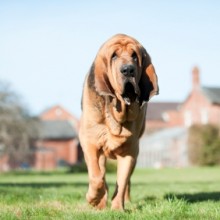Bloodhound
Lifestyle Needs

The Bloodhound is a very large dog, famous for his ability to follow a scent, particularly human scent, over large distances. He is a powerful dog, weighing about 50 kilos and would need a large house with a large garden. He should have plenty of exercise – more than two hours a day – and the opportunity to run free. He needs to be trained well, particularly in recall, to ensure that he doesn’t ‘lose’ himself following a trail. He has a loud bark but usually is not aggressive. His short coat needs grooming regularly.
Genetic Diversity
(Known as Coefficient of Inbreeding: 'COI'. It should be as low as possible.)
The UK Kennel Club breed average COI is 11.7% - See 'A Beginners Guide to COI'
Gene Pool Size
(Known as Effective Population Size: 'EPS')
890.49
EPS is a measure of how many individuals are contributing genetically to a breed population. It is a measure of the size of the gene pool in a breed. Lower than 100 is considered critical by conservationists and below 50 brings a breed close to extinction. For more information see the Kennel Club article.
Health and Welfare Problems due to Conformation
(Body shape and physical characteristics)
- The Bloodhound’s loose skin is prone to skin infections
- Multiple eye problems: His loose eye rims can also be a welfare concern as dirt and dust can irritate his eyes; Ectropion; Entropion; Cherry eye; Dry eye
- His long, pendulous ears can become injured whilst dragging along the ground following a scent.
BVA/KC Health Schemes: www.bva.co.uk/chs
- Hip dysplasia: breed 5 year mean score 13.3(parents should be lower)
- Elbow dysplasia: score ideally 0:0
- Eye disease: Multi-ocular defects (MOD) (Schedule B) (litter screening)
- BVA/KC Heart Testing Scheme
- The Bloodhound is one of the 15 high profile breeds designated by the Kennel Club as requiring particular monitoring by reason of visible conditions which may cause health and welfare concerns.
Identified by the UK Kennel Club as part of their Breed Health and Conservation Plan
Estimated Breeding Values (EBVs) : No EBVs are currently available for this breed
www.thekennelclub.org.uk/about-ebvs
DNA Tests Available
DogWellNet and IPFD Harmonisation of Genetic Testing for Dogs (HGTD)
www.dogwellnet.com/breeds
None relevant
Availability of a DNA test does not mean that it is always necessary or even desirable for breeders to use this test.
Other Breed-Specific Health Screening Schemes
- Bloodhound Information website
- http://www.bloodhoundhealth.com
Ask the breeder to show you the certificates for the above tests/screening for both parents. If any of the above tests have not been considered necessary by the breeder (and there may be good reasons), ask her to explain why.
Other Diseases Reported
(For which there are currently no genetic or screening tests for sire or dam)
- Ectropian
- Entropian
- Dermatitis
- Gastric dilatation volvulus (GDV)
- Cancer
- Heart disease
Ask the breeder about the medical history of the parents, grandparents and great grandparents. Consider carefully whether to purchase a puppy if some of these or other diseases are in the family line.
Ask about the breeder’s policy in cases of serious genetic diseases occurring to your puppy in later life. Good breeders will request to be informed of such events in order to improve future breeding decisions.
You are strongly advised to buy from a breeder who uses (or is prepared to use) the AWF Puppy Contract and Puppy Information Pack (PIP): www.puppycontract.org.uk
The breeder should also be familiar with the CFSG/DBRG Code of Practice for Dog Breeding